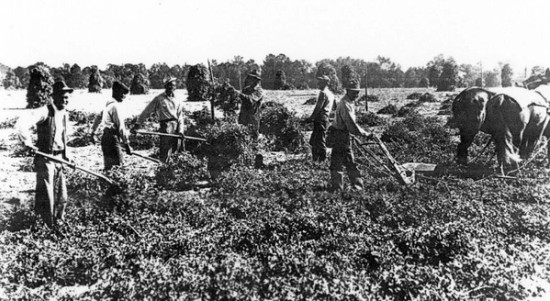1700s
Oxen and horses for power, crude wooden plows, all sowing by hand, cultivating by hoe, hay and grain cutting with sickle, and threshing with flail
1797
Charles Newbold patents first cast-iron plow
Early 1800s
1819
Jethro Wood patents iron plow with interchangeable parts
1834
John Lane manufactures plows faced with steel saw blades
1837
John Deere and Leonard Andrus begin manufacturing steel plows; practical threshing machine patented
1840s
Factory-made agricultural machinery increases farmers’ need for cash and encourages commercial farming. First fertilizers sold commercially.
1847
Irrigation begun in Utah
1856
Two-horse straddle-row cultivator patented
Late 1800’s
1862-75
Change from hand power to horses characterizes the first American agricultural revolution
1865-75
Gang plows and sulky plows come into use
1868
Steam tractors are tried out
1869
Spring-tooth harrow for seedbed preparation appears
1890s
Agriculture becomes increasingly mechanized and commercialized
Early 1900s
1900-10
George Washington Carver of Tuskegee Institute finds new uses for peanuts, sweet potatoes, and soybeans, helping to diversify southern agriculture
1905
The first business devoted exclusively to making tractors is established
1910-15
Big open-geared gas tractors introduced in areas of extensive farming
1914
Smith-Lever Extension Act passed setting up a national extension farm service, still active today.
1918
Small prairie-type combine with auxiliary engine introduced
1920-40
Farm production gradually grows from expanded use of mechanized power
1930s
All-purpose, rubber-tired tractor with complementary machinery popularized
Late 1900s
1945-70
Change from horses to tractors and increasing technological practices characterize the second American agricultural revolution; productivity per acre begins sharp rise
1951
Organic chemicals are found to help protect plants against certain deficiencies
1954
Number of tractors on farms exceeds the number horses and mules for the first time
1970s
No-tillage agriculture popularized
1980s
More farmers use no-till or low-till methods to curb erosion
1989
After several slow years, the sale of farm equipment rebounds; more farmers begin to use low-input sustainable agriculture (LISA) techniques to reduce chemical applications.
1990s
Information technology and precision techniques increasingly used in agriculture
1994
Farmers begin using satellite technology to track and plan their farming practices. The user of conservation tillage methods, which leave crop residues in the field to combat erosion, continues to rise. Farm Bureau celebrates its 75th anniversary. U.S. Congress approves General Agreement on Tariffs and Trade (GATT), helping liberalize world trade.
21st Century
2000-2016
Tractors guided by an internal GPS and a stored map of the field become prevalent, allowing for more precision, efficiency and cost savings.
Even though most U.S.A. peanut farms are family-owned and operated, today’s farmer integrates the latest in precision agriculture, crop and digital technology, new machinery and agricultural software to help manage the farming business.
Sources:
www.agclassroom.orggan/timeline/farm_tech.htm
http://www.answers.com/topic/agriculture-since-the-industrial-revolution#ixzz29P4eZ4vt
